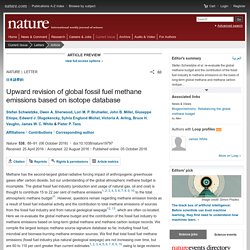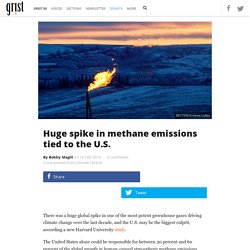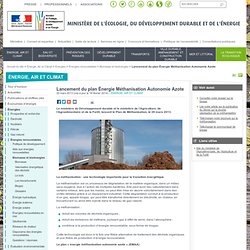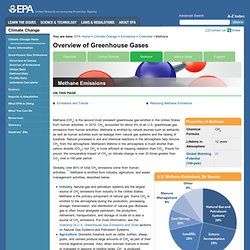

L’administration Trump veut alléger le contrôle des émissions de méthane Mise en service commerciale du terminal méthanier de Dunkerque. Depuis le 1er janvier 2017, le terminal méthanier de Dunkerque a débuté ses activités commerciales.

Cette mise en service vient clôturer ce qui fut l’un des plus grands chantiers industriels en France. The World's Methane Output May Be Double What We Thought. New research finds that the amount of methane produced around the world may be nearly double the previous estimate.

Past data has suggested that methane and other so-called super insulating gasses, which have a much greater global warming effect than carbon dioxide, are a pressing issue if we want to keep below the 2C warming threshold that science tells us will be the tipping point for widescale climate change problems. However, science is always looking to expand both the scope and detail of its data. That’s what researchers from the University of Colorado and U.S. science agency NOAA have done by compiling the world’s largest database of worldwide methane emissions. Love This? Never Miss Another Story. Thanks for subscribing!
To do this, the researchers looked at the isotopic composition of methane from thousands of air samples from around the globe. Upward revision of global fossil fuel methane emissions based on isotope database : Nature. Affiliations Cooperative Institute for Research in Environmental Sciences, University of Colorado, Boulder, Colorado, USA Stefan Schwietzke, John B.

Miller & Victoria A. Huge spike in methane emissions tied to the U.S. There was a huge global spike in one of the most potent greenhouse gases driving climate change over the last decade, and the U.S. may be the biggest culprit, according a new Harvard University study.

The United States alone could be responsible for between 30 percent and 60 percent of the global growth in human-caused atmospheric methane emissions since 2002 because of a 30 percent spike in methane emissions across the country, the study says. The research shows that emissions increased the most in the middle of the country, but the authors said there is too little data to identify specific sources. However, the increase occurred at the same time as America’s shale oil and gas boom, which has been associated with large amounts of methane leaking from oil and gas wells and pipelines nationwide. The Aliso Canyon gas leak in California, which was plugged last week after a nearly four-month effort to contain it, has brought new attention to methane.
The U.S. Ask Umbra: Is there an easier way to get natural gas? Send your question to Umbra!

Q. Dear Umbra, Why are companies so determined to violate the geological structure of the planet in search of methane when almost everything that is alive or decaying produces it naturally? Would it not be cheaper and safer and cooler to just use what is already being produced limitlessly? Anusha Melbourne, Australia A. Listen, I don’t want to freak you out. Except! The primary component of natural gas, methane is produced when living things rot without oxygen around. The fact that this natural gas is abundant, affordable, and cleaner-burning makes the world keen on it. But this “unconventional extraction” of methane, as it’s known, is not without downsides. So why does the energy industry go to all this trouble instead of, say, using a Ziploc bag to catch those cow burps?
Lancement du plan Énergie Méthanisation Autonomie Azote. La méthanisation : une technologie importante pour la transition énergétique La méthanisation est un processus de dégradation de la matière organique, dans un milieu sans oxygène, due à l’action de multiples bactéries.

Elle peut avoir lieu naturellement dans certains milieux, tels que les marais, ou peut être mise en œuvre volontairement dans des unités dédiées grâce à un équipement industriel. Cette dégradation conduit à la production d’un gaz, appelé biogaz, qui peut être transformé directement en électricité, en chaleur, en biocarburant ou alors être injecté dans le réseau de gaz naturel. La bombe méthane est amorcée. Pour la première fois, une équipe de scientifiques a pu noter et mesurer la libération de millions de tonnes d'hydrures de méthane, enfouies dans le permafrost sous-marin de l'Arctique, un phénomène que les théoriciens du climat appréhendaient parce qu'il pourrait rendre incontrôlable le réchauffement du climat par des apports de gaz à effet de serre inimaginables jusqu'ici.

La nouvelle a été publiée hier par le journal britannique The Independant à partir d'informations transmises par une équipe de chercheurs suédois en mission sur le navire de recherche russe, le Jacob Smirnitskyi. Methane Emissions. Methane (CH4) is the second most prevalent greenhouse gas emitted in the United States from human activities.

In 2012, CH4 accounted for about 9% of all U.S. greenhouse gas emissions from human activities. Methane is emitted by natural sources such as wetlands, as well as human activities such as leakage from natural gas systems and the raising of livestock. Natural processes in soil and chemical reactions in the atmosphere help remove CH4 from the atmosphere. Methane's lifetime in the atmosphere is much shorter than carbon dioxide (CO2), but CH4 is more efficient at trapping radiation than CO2.
Pound for pound, the comparative impact of CH4 on climate change is over 20 times greater than CO2 over a 100-year period.